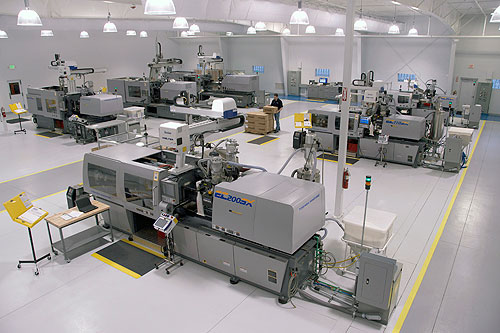The View from 30 Feet: Philosophy of Facility Size
by Dianna Brodine
Plastics Business
Business gurus often talk about the view from 30,000 feet – the big picture that provides a look at overall operations. Perhaps, however, the focus should be on the view from 30 feet – a close-up of specific processes and procedures that make an impact now.
As the economy has rebounded and growing consumer confidence has translated into a willingness to spend money, many plastics molders have found themselves in a position where expansion was necessary to meet customer needs. However, according to Gerry Phillips, co-owner and vice president of PRISM Plastics, Inc., bigger isn’t always better. PRISM caps its facilities (three, so far) at 16 presses. When demand at one facility necessitates additional capacity, another machine isn’t an option... but another facility is.
Despite a business philosophy that seems, at best, limiting and at most disastrous, PRISM has grown from $5 million in revenue in 2009 to more than $30 million in 2014. Phillips believes $100 million is achievable by 2020.
Founded in 2000 by three former Huron Plastics executives, PRISM currently has three processing facilities, with locations in Chesterfield, Michigan; Port Huron, Michigan; and Harlingen, Texas. With a highly automated environment focused on low-tonnage, tight-tolerance, high-volume, difficult-to-mold parts for Tier 2 and Tier 3 customers, the company’s profit margin is driven by its ability to produce the greatest number of good parts per hour.
Seventy employees running 24/7 in three facilities manufacture more than 500 million parts per year. These include components for seat belts, air bags, fuel and brake systems and steering mechanisms. Ninety-nine percent of the company’s parts are never touched by human hands. This highly automated environment demands strict process control and, Phillips said, controlling the facility size accomplishes that goal. "Our entire philosophy is built around controlled production," he said.
All of the company’s machines are identical, uniform and interchangeable across all facilities. PRISM utilizes only electric Toshiba molding machines, although the tonnage can range from 65 to 390 tons. Only Yushin robots are used on the production floor. All auxiliary equipment can be moved from one press to another. In addition, changes are not implemented in any facility – for instance, a change in the frequency of preventative maintenance for tooling – unless it makes sense to implement the change across all facilities. If a process is modified, every step is documented so it can be instituted in a uniform way across every plant. "When the complexity number goes up, processes are no longer in control. In turn, that reduces the number of good pieces per hour we can produce," Phillips explained. "And, when it’s boiled down to how we make money, it all relates to the number of good pieces per hour."
While PRISM’s mirror-image facilities might not be a surprise, its 16 press limit is more unusual. Each facility’s shop floor is staffed with three technicians per shift, plus a maintenance person and a shipping/receiving employee. Those five employees effectively can run 16 machines. Adding additional molding machines would have a domino effect, requiring additional technicians and support personnel. "We’ve studied the time effectiveness," Phillips said, "and anything beyond 16 presses would affect the leanness of our operations."
"We don’t do a lot of different things," said Phillips. "Instead, we do a few things very well. Our facilities are designed for flow and process control. We have no quality control department or quality inspectors, because we have a tightly controlled environment and everyone, from accounting and sales through production, is responsible for the quality of their work. Processes are written and controlled so they can be repeated every time. If we add more than 16 presses, our ability to create a high number of good pieces each hour is affected."
With revenue increasing more than $25 million in six years, PRISM’s facility size philosophy obviously is not limiting its growth. In fact, the company will be erecting another facility within the next 12-18 months, although its location has not yet been determined. Another benefit of the strict adherence to process control is apparent when it’s time to expand. "Because our facilities are uniform and interchangeable," said Phillips, "from the time we decide to put up a plant to the time we’re in production is about six months."
PRISM Plastics currently is 100-percent automotive, but the company is making a concerted effort to move into medical molding, possibly by acquisition. Phillips also says the company is generating new opportunities every day simply by being the very best at what it does. "For the types of parts and products we make, we’ve really right-sized these plants," he said. "Growing beyond 16 presses creates a less controllable environment, which means the teams spend more time putting out fires than anticipating and solving problems. We’ve made an effort to stay consistent, and we have a model that works. There’s no reason to limit ourselves when we look ahead to what is possible."

